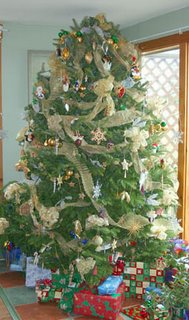Gnomey, the garden blogger at
Kingsbrae Gardens in St. Andrews, NB, made a good point the other day. How many new cultivars of hostas, heucheras or daylilies do we really need? Every year, there are countless new cultivars of perennials, vegetables, annuals, shrubs…you name it and there’s probably a new cultivar or two on offer. And while this is a very good thing in some ways for us gardeners, on the other hand it can be daunting for new gardeners to deal with. Which of the forty-seven heucheras should she plant in her garden? If there’s only room in his tiny back yard for one hosta, should it be Sagae, Paul’s Glory, Revolution, or Guacamole?
At the same time, many of us get very excited when we read about new and beautiful plants in magazines or catalogues or here on the Web. And believe it or not, while it’s daunting for home gardeners of all abilities to figure out what new plants to try—or even what new plants are out there, it’s even more daunting for those of us who are garden writers, who are expected to keep somewhat ‘up’ on what’s new and hot.
So what I’ve decided to do is pick out ten of my favourite old standards (perennials to start with) and profile each of them; then we’ll move to ten of the newest plants, whether they’re brand new and not even in our home gardens yet, or some that have come out in the past year or so. This should give us plenty of things to talk about over the next few entries…plus, it will make me think seriously about what my favourite plants are, and why; a good offering to suggest to new gardeners when they come to me asking about what they should plant. That’s always a tricky thing to suggest. “Plant what makes you happy” is what I tell people, and if they have specific interests I’m pleased to direct them to growers who specialize in one genus or another; daylilies, hostas, shrubs, heucheras, alpine plants, grasses…but we’ll talk about some general favourites of mine. Including, of course, both pros and cons.

First on the list is the coneflower, or Echinacea. To be technical, there are several different genera that are referred to as coneflowers; Rudbeckia, Ratibida, and Echinacea. While I like the first two just fine, I simply adore Echinaceas, so that’s the one I’m focusing on here.
Coneflowers make me instantly happy when I look at them in bloom. They are so tidy looking, with those striking central cones in various shades (depending on species/cultivar), and their neat, symmetrical ring of petals. Sure, there are plenty of daisy-flowered garden perennials, but echinacea has to be the star of them all.

And even now, in late January, there are still cones hanging on in the garden, providing food to some songbirds and winter interest to the gardener.
Coneflowers perform best in full sun in well-drained soil, amended with compost or well-rotted manure. They’ll do okay in part shade but won’t bloom as heavily, and while some of the older species and hybrids usually do fine in my back bed, which is prone to being a bit on the wet side, last year one rotted off due to the excessive amounts of wet and rain. Clay isn’t good for them, and while I work away at adding as much compost and manure to that back bed as possible, it all takes time. The front beds, where drainage is better, is where our coneflowers have done best.
One of the funniest ongoing jokes my longsuffering spouse and I have is about the name “Purple coneflower”. When I was growing one of the white hybrids, he asked me what it was, and I told him it was a ‘white purple coneflower’. Well. He wanted to know how a plant could be purple when it was white. I told him I didn’t make up the names. He then proceeded to declare the ‘Black Beauty’ Rudbeckia a black purpleconeflower. I explained that it wasn’t a purple coneflower, it was a rudbeckia. Didn’t matter. He now torments me about orange purple coneflowers, yellow purple coneflowers, and wants to know when there will be a blue purple coneflower. Okay, it strikes me funny, but maybe you had to be there.!
Speaking of all those different colours; echinaceas are a plant breeder’s delight. In the past four or five years, there have been a number of different coloured coneflowers launched on an unsuspecting public. Perhaps the first was one of those developed at the Chicago Botanical Gardens: Art’s Pride, or Orange Meadowbrite. It’s truly orange, and its fragrant too. People who know more about plant breeding than I do tell me that many of the funky new colours are the result of crossing E. purpurea and E. paradoxa, and this is why some of the newer coneflowers have more lanceolate leaves and thinner petals than our old standards. Whatever the case, they are marvelous.
I’ve heard rumblings from some gardeners about the newer ones being harder to overwinter. So far, (touch wood) our plants have settled in well and the older ones came through their first winter just fine. To be on the safe side, I did cover the new cultivars that I put in last year with evergreen boughs, just to help them get through their first Atlantic Canadian winter.
From Georgia’s ItSaul Nursery come the Big Sky series of coneflowers, which I have quickly become besotted with. I currently have Sunrise (yellow)

and Sundown (peachy-rose-orange, depending on the age of the flower)

and I THINK there’s a Sunset out there too, but you know about me and LoLas…There are more to get my mitts on, including Harvest Moon and Twilight, Summer Sky and After Midnight, all from ItSaul Plants, so I look forward to seeing them in the not too distant future.
But wait, there’s more. Others are breeding coneflowers too, and bringing in interesting variations. I haven’t seen “Green Eyes’ around here yet, a native purple coneflower with a green cone,

but I did see it in Toronto and of course I covet it….(this one was taken late in the season and the green is waning, but you get the idea.) I'm looking forward to seeing it in Nova Scotian nurseries this year, or else I'll have to break down and order it from somewhere else.
From
Terra Nova Nurseries out in Oregon comes the pumpkin orange ‘Tiki Torch’. If the photo's colour is accurate and not enhanced, this striking new cultivar should excite those of us who hanker after such beautiful plants. (photo courtesy of Terra Nova)
















































